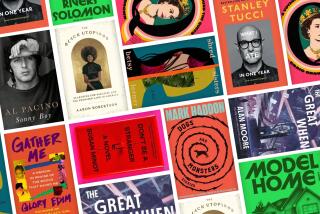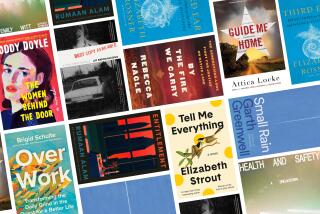Last Year-End Roundup Assesses the Slicks and the Slims
Ponder the sea gulls pecking for aromatic kitchen scraps among the flapping pages of the thousands of magazines that blanketed the country this year in weekly, monthly and seasonal waves, before bulldozers shoved them into ever-deepening strata in America’s sanitary landfills.
Ponder, too, that millions and millions of brains nationwide have absorbed a year’s worth of magazine content--brilliant, mediocre and inane.
Now, before that information decomposes, let’s try to scavenge what we can from another extraordinary year in magazinedom. Here, in no particular order--and with a thousand exclusions for every mention--are a few highlights:
*
Most Improved: Mother Jones, the old ‘60s radical, revivified itself by simply returning to the revolutionary notion that good reporting tells both sides of a story. Suddenly MoJo reporters are revealing that, “Hey, not all pro-abortion protesters are crazy; not all pro-choice types are saints,” and “Hey, not all academic feminists put their students’ futures first!”
The magazine remains true to its progressive roots. But it has abandoned the propagandistic bent that undermined reader interest. As a result, the old gadfly has become an extremely lively forum for ongoing debate among readers and contributors.
*
Most Conflicted: As part of a devastatingly biting satire of the New Yorker on its first anniversary under Tina Brown, Spy magazine produced a spurious quote, in which the most famous editor in the world compared her tenure at America’s snootiest magazine to transforming an abandoned 14th-Century church into “one of the most elegant mini-malls in Britain.”
It’s interesting that the Spy issue--with a faux topless, cupcake-shielded Brown on the cover--arrived the same month that the New Yorker published Janet Malcolm’s extraordinary book-length look at poet Sylvia Plath.
Brown has made the magazine more crass, with articles so frothy they cause brain rot, cartoons of needless vulgarity, and a sad streak of Hollywood puffery. She has also published articles as fine as any it has ever printed, while making it more relevant and provocative. Some covers are brilliant and the cartoons are, overall, much funnier.
*
Most Potential: Because both have fixated on upscale Westside readers, Buzz and Los Angeles magazines remain locked in combat for the imaginary title of Hottest ‘Zine in Town. The result is that all too often each is far too trivial. Each also publishes the occasional gem. And Buzz, in particular, deserves credit for consistently taking swipes at the city’s dominant media--although, as Los Angeles’ editor recently pointed out, for the writer to do so anonymously is pretty gutless.
While neither magazine is perfect, if either goes belly up, Angelenos will find their journalistic pickings in magazines even slimmer than at this anorexic moment.
*
Best Issue: In a world where masthead hopping is as institutionalized as perfumed ad inserts, Terry McDonell’s firing from Esquire got a lot of attention. The irony is, his best effort was already on its way to the printer. Esquire’s “60th Anniversary Issue,” with an stimulating array of essays and articles by everyone from Norman Mailer to Ice T, is a classic.
From the looks of the magazine’s hilarious Dubious Achievement issue, which was nurtured during McDonell’s reign, but features new editor Edward Kosner on the masthead, the transition will be a smooth one.
*
New on Newsstands: With the advertising economy apparently improving by degrees, a variety of upstart publications seem poised on the brink of survival. Among the more notable launches:
Family Life, like its young sibling Men’s Journal, emerged as an upscale niche publication. Both already rival their parent Rolling Stone in quality and adventurousness. Forbes MediaCritic promises to keep a conservative watchdog eye on news hounds of every persuasion. National Times does a fine job of selecting and reprinting all variety of newspaper and magazine articles. Beer--The Magazine is geared to gourmets, not guzzlers.
And Bubba replaces Quayle Quarterly as a narrowly focused political satire. In this case, the targets are the President, “whose hair wouldn’t look out of place at a Christian tractor pull,” the First Lady, and the State of Arkansas, where folks “think thirtysomething is how many beers $15 will buy.”
*
Ongoing Achievement: The New Republic continues to shake things up like no other journal--from its smart critique of the Clinton Administration’s “politics of meaning” blather to an analysis of the “diversity industry,” in which woefully overpaid consultants presume to solve corporations’ multicultural problems. The Nation never lets up in nipping at the heels of entrenched economic fat-catism and fatheadedness in government. Heterodoxy remains unflagging in its ability to make the politically correct writhe and twitch in rage.
Spin and Details both do an excellent job communicating to the supposedly illiterate twentysomething folks who, these magazines are sufficiently hip to understand, loathe all pinheaded efforts to label them as slackers or Generation X.
Cricket, Spider and Ladybug offer consistently high quality, age-specific children’s literature. Ranger Rick and Your Big Backyard are among the great nature magazines for kids. Sports Illustrated for Kids is as good in its way as the adult version. And Disney Adventures, while shamelessly linked to Disney products and programs, is a monthly favorite with the crumb snatchers.
Harper’s, The Atlantic, Reason, Discover, Family Therapy Networker, Lingua Franca, Backpacker and Redbook are widely disparate in style, content, even paper quality. But they have a common, consistent dedication to top-notch editorial standards.
The Skeptical Inquirer, published by the Committee for the Scientific Investigation of Claims of the Paranormal, is stalwart in debunking claptrap of every stripe.
In its current issue, editor Paul Kurtz offers a reminder that would well serve every magazine reader: “Briefly stated, a skeptic is one who is willing to question any claim to truth, asking for clarity in definition, consistency in logic, and adequacy of evidence . . . Still, skeptics are considered dangerous because they question the reigning orthodoxies, the shibboleths and hosannas of any age.”
As evidenced by his work in GQ, Movieline and Spy, Joe Queenan is the funniest magazine writer of the moment.
And Monk magazine is among the quirkiest and most interesting publications happening. As it says in a special issue dedicated to this city: “L.A. is the world’s great melting pot . . . It’s like an 80 theater multiplex where a whole new country and culture awaits just a door away.”
*
The Future: In April, Spin took a look at new technology that makes ‘zines so easy to produce and concluded: “Technology has fallen into the wrong hands and, as a result, fanzines are everywhere--thousands of pointless, stapled pages of goo-goo-ga-ga, written for losers by losers.”
Meanwhile, most other Earthlings have jumped onto the information superhighway and are already zooming toward the glorious multimedia future. A number of excellent publications have sprouted up to address the budding electro-utopia: Mondo 2000, Wired and Axcess. But in the current, “60th Anniversary Issue” of Newsweek, Dave Barry looks back on the ‘90s and recalls that all in all, the superhighway was “a dud.”
“The problem, of course, was that even that even though the information was coming a lot faster, the vast majority of it, having originated with human beings, was still wrong,” he says. “Eventually, people realized that the Information Superhighway was essentially CB radio, but with more typing.”
All of which brings us back to the print medium, and Bill McKibben, who wrote an essay on our current “age of distraction” in that aforementioned Esquire anniversary issue: “What we need is not additional information--we have, the least-informed of us, more information than a king two centuries ago--but more reflection, more silence and solitude, and darkness to put in context what we know.”
*
R.I.P.: 1.--In June, Cowles Business Media, the owner of Folio magazine bought and closed rival publication Magazine Week--a major loss for magazine junkies.
--This column. Farewell.
More to Read
Sign up for our Book Club newsletter
Get the latest news, events and more from the Los Angeles Times Book Club, and help us get L.A. reading and talking.
You may occasionally receive promotional content from the Los Angeles Times.








